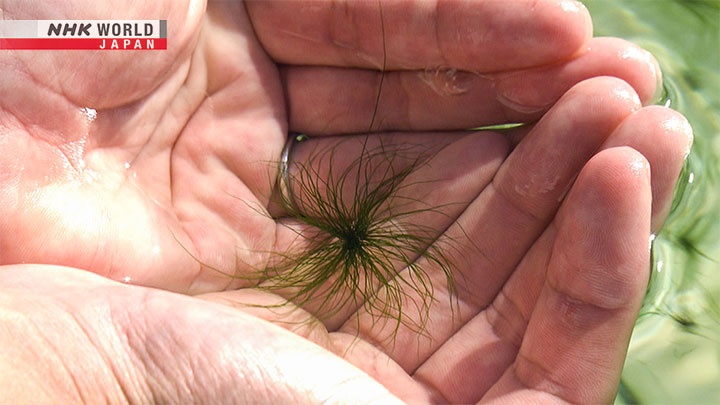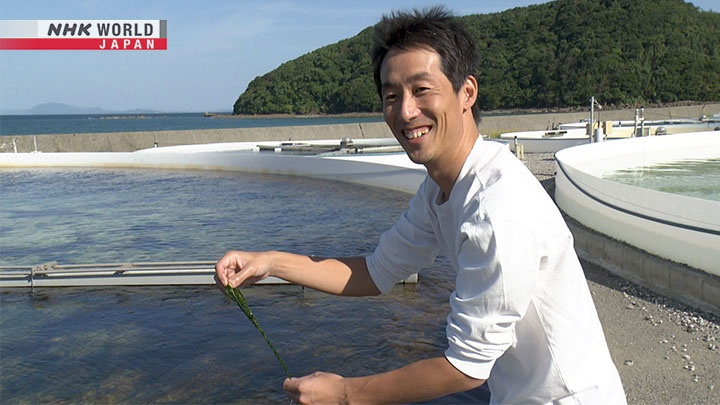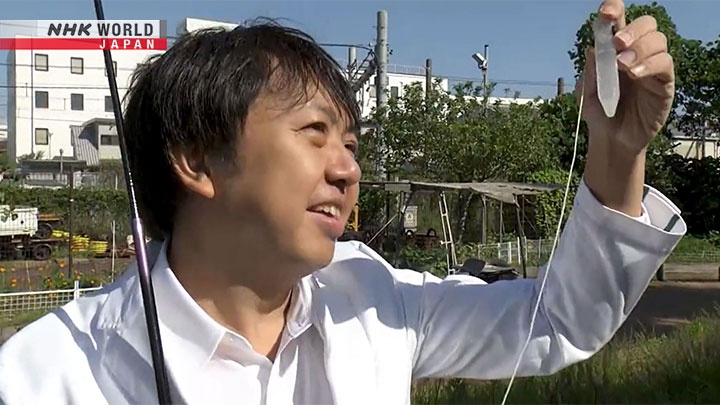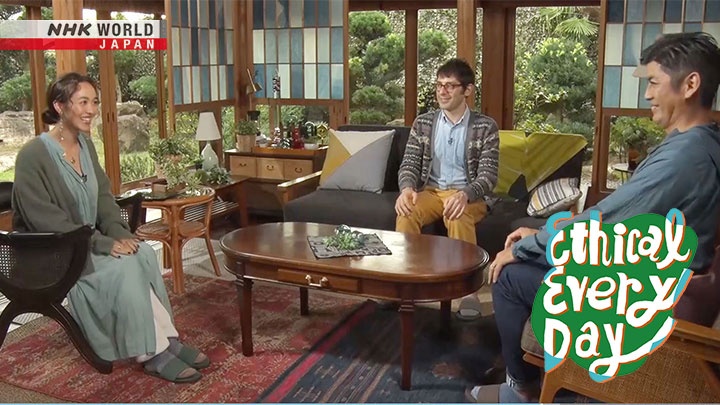Super Ethical Seaweed!
Rich in nutrients, seaweed is gaining attention as a superfood. It also has lots of potential in tackling environmental issues. From Japan to the world, the amazing possibilities of seaweed!




Transcript
Have you ever tried eating seaweed?
In Japan, it's long been used in things like sushi and miso soup.
Recently, it's being embraced on an even wider scale.
It's packed with minerals, fibers, and other nutrients.
Some people even call it an "ocean superfood."
And it just needs seawater and sunlight to grow, so it's environmentally friendly.
It's so good for you.
It's important for the sea, too.
Today, from Japan to the world, the amazing potential of seaweed!
- Hey, Alisa!
- Hey, Matthew!
- You know what time it is?
- What time is it?
- Snack o'clock!
- Ooh, I smell something really good!
- Yeah! Ta-da!
- Wow, is this toast with seaweed on top?
- It certainly is!
- How did you come up with the idea?
Well, I love seaweed, with a capital L, and actually, growing up, I ate a lot of it in my family, in my house.
- Oh, I see.
- Yeah.
So, this type of seaweed is a rare variety called "suji-aonori."
And it's got a really remarkable scent.
- "Itadakimasu."
- "Dozo, dozo."
Hey, Alisa! Hey, Matthew! Oops, sorry to interrupt your meal.
- I bet people would enjoy eating seaweed even more, if they knew just how nutritious it is.
- True!
Seaweed is packed with minerals like iron, magnesium, and calcium.
It's also got lots of vitamins and fiber.
It has lots of protein, too.
For example, the kind of seaweed used in sushi is 40 percent protein!
That's even more than soybeans.
What's more, seaweed grows with sunlight and seawater through photosynthesis, and sucks up carbon dioxide in the process!
- By the way, Matthew...
- Yes?
I heard you already had a bit of a head start on learning about seaweed and how to eat it.
Oh, that's right, House.
Actually, Alisa, I met some really cool folks, who see seaweed as a promising food for a better future.
They're coming up with really unique, innovative ways to grow it, and recipes that make this food super delicious.
- Wow, I'm really interested.
- Yeah, so let's check it out before we dine.
Amakusa, Kumamoto.
This scenic area is made up of 120 islands of various sizes.
Here, suji-aonori is grown in a way that's quite unique.
Not in the sea... but on land!
This is an onshore suji-aonori aquaculture farm.
A huge amount of fresh suji-aonori is grown here.
Oh, it's gotten bigger.
This is onshore cultivator, Hachiya Jun.
It's a very aromatic, flavorful,
high-end seaweed.
Suji-aonori has long been prized in Japan as a high-end culinary product.
Hachiya and his team began cultivating this seaweed onshore seven years ago.
They now ship it nationwide.
How do they grow seaweed onshore? They gave us special permission to take a look.
This is how it looks when it's smallest.
We grow it from this stage.
This is suji-aonori.
At this point, it's just around 0.1 millimeters in size.
They use a special method to take spores from natural suji-aonori, then grow them in their tanks.
In the wild, suji-aonori grows from fall to winter, so the tanks are set from 15 to 20 degrees Celsius.
Progressing well.
There are more than before.
Once they reach about one millimeter, they're moved into a large outdoor tank.
The water in the tanks is fresh seawater pumped from underground.
This means mineral-rich seawater, with the right temperature for suji-aonori, can be had throughout the year.
The color of the tanks also has a special purpose.
Because it's totally white, the sun's rays are reflected throughout.
The water is also slowly stirred.
This helps light reach every surface of the suji-aonori, allowing for efficient photosynthesis.
Onshore growing is all about how efficiently
you can get sunlight to the seaweed.
In nature, suji-aonori latches onto things like rocks and stones.
But in these onshore tanks, there are no rocks.
The seaweed simply drifts on the water.
There is a reason behind this.
Cultivating onshore,
if you provide somewhere for it to latch onto,
you have to cut it from that place
when you harvest.
That takes a lot of time and effort.
So our method is to just have it float,
without latching onto anything.
However, without latching onto anything, suji-aonori won't grow well.
The solution is to have it entwine around other suji-aonori.
Each of these hair-like strands is aonori.
This is a collection of many strands.
By growing them in this form,
they don't latch onto the walls.
They grow while feeling they're
latched onto something.
By using this unique method, they can successfully cultivate seaweed on shore.
They now have locations around the country, in places like Kōchi and Mie, and cultivate 30 types of seaweed, including suji-aonori.
Aside from cultivating algae, there is also innovation on the gourmet front. Let's check it out!
Matthew visits a small building in an alleyway in Tokyo.
Something smells delectable.
I wonder what it is they're preparing.
This is a "test kitchen," run by Hachiya's company.
They create new seaweed-based dishes, and hold tasting sessions with world-famous chefs and restaurateurs.
- Hello, I'm Matthew.
- I'm Shui.
- Nice to meet you.
- Very nice to meet you.
This is chef Shui Ishizaka.
Actually, something that I'll show you now, that's something...
that's... we've been working on for the last couple of days, and maybe I'll get you to be the first person to taste it.
Oh, that's exciting!
- Wow! It looks a lot like a kind of matcha dessert.
- Humm, it could be!
It's very sweet.
This one is a mousse.
Everything that flavors this mousse is purely from the aonori.
This is not what comes to mind when I think about seaweed.
It's surprising that the dairy goes so well with this... this marine life.
Yeah, right? The first time that I tried it, like I said, it was like, wow, I couldn't believe it!
Ishizaka was born in Australia, and has developed dishes for a top restaurant in Tokyo.
He's now creating new dishes to help people learn about the charms of seaweed.
A chocolate cake he made using seaweed made a splash at an international chocolate fair this year.
How many varieties of seaweed do you think exist in Japanese seas alone?
In my house, I would say there are three varieties.
And... that's probably more than the average person.
Maybe thirty? I'm sure there are more, but how many are there?
- So, again, in Japanese seas alone, there's over 1500.
- WOW!
There's so much seaweed out there, that just hasn't been discovered in terms of its culinary potential.
This particular seaweed is a current favorite of Ishizaka's.
It's called "mirin." Not much of this seaweed is harvested, and it's hard to get your hands on, so even some seaweed fans have never tried it.
It almost like snaps.
- Surprisingly taut when you cut it, it's not as soft as I would expect.
- Exactly.
Ishizaka places the mirin on some tender eggplant.
That is a very new eating experience, wow!
Mmm, I've never had quite anything like this before... it is unique!
It's not at all like the nori that's used to prepare sushi, or the kombu that goes in miso soup with the wakame oftentimes.
So, as far as I know, there's nothing, in the vegetable and fruit world, that has this sort of texture, of this mirin.
Growing seaweed, creating recipes and expanding what people eat.
Ishizaka, Hachiya, and their team will continue to open up new possibilities for seaweed.
- I actually brought you back a little something.
- Yay! Thank you!
- Ta-da!
- Wow! What is it? It looks pretty, the color...
- Yeah, it's actually a drink made from fermented seaweed.
- Ah... no way!
Yeah, Ishizaka-san and his team created this so people can casually try it out.
- The same way you would a wine with a meal.
- I see.
Yeah... so, they call it kind of like "sea wine."
- Sea wine?
- Yeah.
Let's see... Hmm, interesting!
It's not salty, it's more sour, I would say, a little sour; but it's really good.
But there is one problem, right?
- So, a lot of seaweed is actually disappearing from the seas in Japan.
- Yeah, unfortunately, yes.
And of course a big part of that, one of the leading causes is the rise in ocean temperatures, due to climate change.
- You're quite a seaweed expert, Matthew!
- Well, thank you, House.
This is a phenomenon called rocky-shore denudation, or "isoyake" in Japanese.
It's become a huge problem in recent years.
In Japan, seaweed mainly grows in fall and winter, when water temperatures fall.
But because of climate change, water temperatures are warmer, so seaweed is harder to grow.
On the other hand, warmer temperatures have caused sea urchins and fish to become active year-round.
They love seaweed, but when they eat it before it has a chance to grow, that also leads to a shrinking supply.
In the end, due to a lack of seaweed, those urchins and fish don't have enough food to grow big and strong, and start to disappear.
I see, because the amount of seaweed in the ocean is decreasing, Hachiya-san and his team are trying to grow them on shore.
That's right, but they're actually working to grow it in the sea, too.
So let's check out how they're doing.
Today, employees from Hachiya's company are visiting a local fisher.
- Good morning.
- Morning.
Susaki Tatsumi has been fishing the waters of Amakusa for over 50 years.
He's noticed a decline in seaweed, especially over the last few years.
We used to harvest a lot and sell it to traders.
There was some the last couple years,
but none this year.
Seaweed is disappearing from the seas of places like Amakusa, due to factors such as climate change.
Hachiya, who studied seaweed at university, has dived in seas around Japan.
Wherever he went, he felt the waters were changing for the worse.
So, in 2016, he and a friend founded their company to specialize in seaweed.
With a desire to return seaweed to Japan's seas, Hachiya's company has been working alongside fishers like Susaki for the last three years.
They arrive at a small cove with gentle waves.
On the seafloor are many rocks, so this used to be a place with a lot of seaweed.
These seaweed-filled baskets are placed not on the ocean floor, where many sea urchins live, but near the surface of the water.
Here, the seaweed gets plenty of sunlight for photosynthesis, and the baskets keep large fish from eating it.
This is called "tosaka."
Tosaka was once plentiful here in Amakusa.
Thanks to their efforts, harvest amounts are slowly bouncing back.
And there's this!
The rare variety Matthew sampled known as "mirin."
Mirin is quite sensitive to environmental factors, so the team is attempting to grow it in various seasons and places, with advice from the fishers.
Please grow big and strong!
Seaweed is slowly returning to the seas here.
Small fish gather, trying to eat the fragments falling from the bottoms of the baskets.
In this way, the seaweed supports them, too.
I'm so happy! That mirin is so big.
I hope those small fish lay eggs
and new fish are born.
Back when I was in grade school,
the sea was so full of life.
I want to return it to that state,
with lots of seaweed and marine life.
I want to bring that back.
Alisa, Matthew, our guest today is working on an ethical project to protect seaweed.
Hello.
- Welcome.
- Welcome.
Thanks for having me.
This is Kato Ryu.
Places where a lot of seaweed and
seagrass grow are called "sea forests."
Kato-san works on projects
involving sea forests.
I can't wait to hear more about them.
Kato Ryu has been working with friends to help preserve the seas in Ito, Shizuoka, since 2019.
They hold beach-cleaning events and study tours,
give lessons at schools and more, to impart the importance of the ocean.
In 2023, they launched a site with information on sea forests.
Users can submit data on whether seaweed is growing at parts of the sea they visit.
Anyone can easily submit data from anywhere in the world.
They've received about 400 submissions so far.
Your sea forest site is quite interesting.
What motivated you to start these activities?
We're from the Izu Peninsula.
It's a beautiful place surrounded by ocean.
Our daily lives are linked to the sea.
But as the years go by, fishers report that
abalone, turban shells, etc. are disappearing.
The ones they do catch are small and weak.
They say the reason is lack of seaweed.
So we want to use our site as one way
to help revive sea forests.
I actually tried the site myself.
Oh yeah?
The day before this chat, Matthew visited the beach in Chiba and found some seaweed, adding an entry to the site!
Let me take a look.
Wonder if it's really there.
Found a pin in Chiba!
"I found lots of seaweed washed up on the sand.
It had a nice sea aroma."
You can leave comments and even photos!
It's quite easy to use.
It's very simple, so it's a good first step
that anyone can use.
What's your goal in gathering this data?
There's still a lot about seaweed we don't know.
There's not much research about how to increase it.
When people try to discover how
to improve sea forests,
this site can be used as a resource
for where and how to try things out.
Maybe researchers can use the data
to get hints on locations, seasons, etc.
Our group includes students from high
school to even grade school.
From young kids to people my age.
A very wide range.
We're all working together to pass
on these efforts to future generations.
I'm rooting for you!
Me too!
Thank you.
- Actually, seaweed and other algae are great to eat, but they're also known for something else too.
- Really what?
They've got potential to help produce ethical type of fuel.
Have you heard of biodiesel before?
Of course; that's like the stuff in "Back to the Future 2," that Doc puts into the car to make it fly, like the rotting banana peels and stuff.
- Uh, it's actually quite similar... yeah.
- Okay.
What kind of fuel is it, and how is it made? Let's find out.
This bus in Tokyo has been running on environmentally-friendly fuel for the past three years.
What kind of fuel is it?
It's called bio-diesel.
It's made with euglena.
Euglena? What is euglena, anyway?
We visit a pond to hear all about it from an expert.
Here he is! But what's he doing?
Oh, got some.
Huh? It's hard to see anything.
Our expert takes a look with his trusty portable microscope.
We need further tests to be sure,
but this is likely euglena.
Here it is: euglena.
It's actually algae, just like seaweed, like wakame and kelp.
But how can this algae become fuel?
Our expert, who's been studying euglena for about 20 years, is Suzuki Kengo.
He shows us his company's research lab.
We're growing euglena in this.
Look carefully at this green water to find...
it's filled with tiny euglenas, over 6 billion, in fact.
Euglenas, which have chloroplasts, grow via photosynthesis, absorbing CO2.
Unlike other plants, they grow very
quickly at high density, like this.
They can absorb more CO2, and
produce more useful substances,
than other plants of the same
area or volume.
When oxygen is scarce, these environmentally-friendly euglenas survive by converting the sugar in their bodies into energy.
Oil is stored in their bodies as a byproduct.
Suzuki's company uses that fact to produce euglena oil, that can be used as fuel.
This is powdered euglena.
Let's try to extract some oil from it.
A special liquid is added to this dried and powdered euglena.
It's then mixed.
Next, heat is added to evaporate excess liquid.
What's left is this thick, green liquid: oil!
30 percent of dried euglena can become oil.
It depends on various factors,
but that's about 10 times more than things
like sunflowers, rapeseed or soybeans.
Suzuki realized the potential of euglena as early as his days in university.
But when he first tried to produce large amounts of euglena, things didn't go so well.
When he tried to increase its number, the excess was eaten by animal plankton.
But Suzuki and others realized that some euglena are highly resistant to acid.
Increasing the acid in their culture solution, they created an environment that's difficult for animal plankton to live in.
The euglenas in the tank began to multiply in large amounts.
But the amount of oil that can be harvested from euglena is still small.
We still can't extract enough
to use the bio-fuel on a large scale.
We're still in the development
and research phase.
So, Suzuki's company decided to mix the euglena oil with another material.
They collect used cooking oil from local schools and companies.
This increases the fuel supply, and helps recycle what would otherwise go to waste.
Even so, they only produce about 125 kiloliters per year at present, so it's mixed with about 80 percent diesel fuel to run vehicles.
But not just buses; it can even power airplanes!
This air survey company has used the euglena-oil-based fuel to fuel its airplanes for the past two years.
Decarbonization is becoming a
big part of our operations.
This leads to fewer CO2 emissions
than traditional fuel.
Tests are slowly beginning with small passenger planes and government transport planes as well.
It's starting small.
But I'd like to get to 1%, then 10%,
and then eventually 100% euglena oil.
That will help lead to a
sustainable society.
Those little, single-cell algae powering an airplane... just incredible!
- Amazing, right?
- Yeah.
So, seaweed and algae are nutritious, delicious, absorb CO2, and can even make ethical fuel.
How amazing are they? They're super ethical.
- And we do have this suji-aonori toast.
- Right.
Yeah, time to dine.
- Yes, let's dig in.
- Okay.
- Hmm, smells so good!
- It really does.
How is it?
- It's good. It's really good.
- Yeah.
Why not try some super ethical seaweed in your next meal?
See you next time!